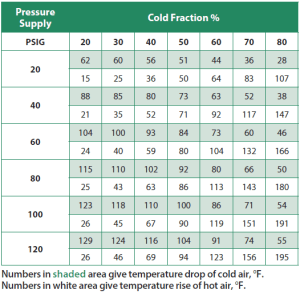A vortex tube is an interesting device that has been looked upon with great fascination over the last 89 years since its discovery by George Ranque in 1928. What I’d like to do in this article is to give some insight into some of the physics of what is happening on the inside.
With a Vortex Tube, we apply a high pressure, compressed air stream to a plenum chamber that contains a turbine-looking part that we call a generator to regulate flow and spin the air to create two separate streams. One hot and one cold.
Below is an animation of how a Vortex Tube works:

The generator is a critical feature within a vortex tube that not only regulates flow and creates the vortex spinning action, it also aligns the inner vortex to allow its escape from the hot end of the vortex tube. Note the center hole on the photo below. This is where the cooled “inner vortex” passes through the generator to escape on the cold air outlet.

Once the compressed air has processed through the generator, we have two spinning streams, the outer vortex and the inner vortex as mentioned above. As the spinning air reaches the end of the hot tube a portion of the air escapes past the control valve; and the remaining air is forced back through the center of the outer vortex. This is what we call a “forced” vortex.
If we look at the inner vortex, this is where it gets interesting. As the air turns back into the center, two things occur. The two vortices are spinning at the same angular velocity and in the same rotational direction. So, they are locked together. But we have energy change as the air processes from the outer vortex to the inner vortex.
If we look at a particle that is spinning in the outer vortex and another particle spinning in the inner vortex, they will be rotating at the same speed. But, because we lost some mass of air through the control valve on the hot end exhaust and the radius is decreased, the inner vortex loses angular momentum.
Angular momentum is expressed in Equation 1 as:
L = I * ω
L – angular momentum
I – inertia
ω – angular velocity
Where the inertia is calculated by Equation 2:
I = m * r2
m – mass
r – radius
So, if we estimate the inner vortex to have a radius that is 1/3 the size of the outer vortex, the calculated change in inertia will be 1/9 of its original value. With less mass and a smaller radius, the Inertia is much smaller. The energy that is lost for this change in momentum is given off as heat to the outside vortex.
Adjustments in output temperatures for a Vortex Tube are made by changing the cold fraction and the input pressure. The cold fraction is a term that we use to show the percentage of air that will come out the cold end. The remaining amount will be exhausted through the hot end. You can call this the “hot fraction”, but since it is usually the smaller of the two flows and is rarely used, we tend to focus on the cold end flow with the “cold fraction”. The “Cold Fraction” is determined by the control valve on the hot end of the Vortex Tube. The “Cold Fraction” chart below can be used to predict the difference in temperature drop in the cold air flow as well as the temperature rise in the hot air flow.

By combining the temperature drops expressed above with the various flow rates in which Vortex Tubes are available, we can vary the amount of cooling power produced for an application. The above cold fraction chart was developed through much testing of the above described theory of operation. The cold fraction chart is a very useful tool that allows us to perform calculations to predict vortex tube performance under various conditions of input pressure and cold fraction settings.
The most interesting and useful part about vortex tube theory is that we have been able to harness this physical energy exchange inside a tube that can fit in the palm of your hand and which has a multitude of industrial uses from spot cooling sewing needles to freezing large pipes in marine applications to enable maintenance operations on valves to be performed.
We would love to entertain any questions you might have about vortex tubes, their uses and how EXAIR can help you.
John Ball
Application Engineer
Email: johnball@exair.com
Twitter: @EXAIR_jb


